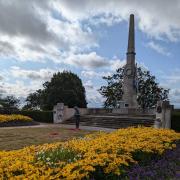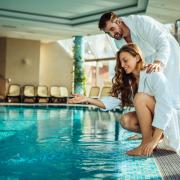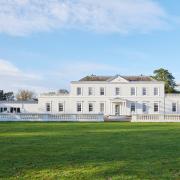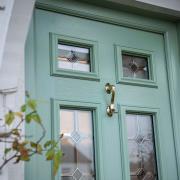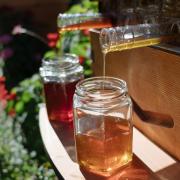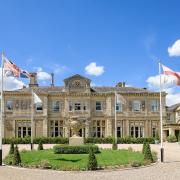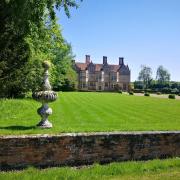In recognition of the 60th anniversary of the release of Goldfinger, based on Ian Fleming’s iconic James Bond novel, now’s the perfect time to look at the little-known connection between Bond and our home county.

Ian Fleming had been working for MI6 before the war when at Reuters, which was owned by MI6, and had been on several missions during the war as either a spy or a Commando while 2IC of Naval intelligence. He turned up in Essex on Whitsun Saturday afternoon 1940, when he and his brother Peter (an Assistant in Military Intelligence) drove in a camouflaged staff car to Southend-on-Sea as a result of the threat of an attack threatened for the following day where they joined a naval observation post on the roof of the Palace Hotel – standing prominently at the shore end of Southend’s famous pier. Their undercover task was to report back any sign of an impending enemy attack, but by the early hours of the morning, with no indication of enemy aircraft movement, they gave up and arranged for their driver to take them back to the capital!
After the war, Fleming continued in the Royal Naval Reserves until at least 1951, in addition to taking on the role of head of Kelmsley Newspaper’s Foreign Department (they owned the Sunday Times). Part of his contract allowed him two months a year in Jamaica, the inspiration for the name James Bond coming from a book on Jamaican birds. This first book, along with many that follow, was inspired by his secret war time overseas experiences, and was written at his Jamaican home, Goldeneye, with the intention of its being ‘the spy story to end all spy stories’ (ianfleming.com) although he could not have predicted what a huge success the books would be. They certainly provided a fantasy escape from still-rationed Britain.

In the summer of 1956, one of Fleming’s influential friends, Ivar Bryce, (related to the Mountbattens) welcomed him to his Grade 1 listed Essex mansion, the 16th century Moyns Park in Birdbrook, North Essex. This picturesque little village in a peaceful setting could easily have influenced Fleming’s creativity. It was here that Fleming was rumoured to finish the final draft of From Russia With Love, published in 1957. Bryce had worked for the British Security Corporation, and was based in Jamaica during World War Two, where he was instrumental in helping Fleming find his Jamaican house, Goldeneye, named after a wartime project in Spain. An American CIA agent, a friend of Bond, was named Felix, (Bryce’s middle name) and featured in several novels, with a Mr Bryce featuring on the train journey in Doctor No. In 1975, Bryce wrote You Only Live Once, regarding his memories of Ian Fleming.
In 1959, Fleming met and befriended Captain Peter Mason, a secret service agent; too late for him to have been Fleming’s inspiration for Bond but he did not need inspiration, given his background. However, Mason, who had a licence to kill, seems to have advised Fleming on weapons and gadgets used in the secret service. Some of these gadgets, especially those used during the Cold War, are on display in the Combined Military Services Museum in Maldon, Essex. These include guns disguised as pens or lipsticks (the latter known as the kiss of death), a camera built into a pack of cigarettes, an umbrella that injects poison pellets, shoes and coins with concealed blades and a pipe which concealed a gun.

It seems that Fleming felt that the growing success of the Bond novels required the books themselves to have better and more striking covers. The first four novels had sold well, and his wife, Ann, agreeing with Fleming’s idea, went to see some of Richard Chopping’s work at an exhibition in London in 1956. Chopping, born in Colchester in Essex, was an English master of trompe l’oeil and Ann had a private tour, thanks to the artist Francis Bacon, the primary exhibitor, leading to a meeting between Fleming and Chopping. Their meeting resulted in a commission to design the jacket for From Russia, with Love, beginning Chopping’s connection with the world of James Bond. Fleming had a further connection with Bacon in that the latter painted one of his portraits of his friend Lucian Freud in Jamaica while visiting Ian Fleming at Goldeneye, a tiny image but which sold for over £3,000,000.

Both Chopping and Francis Bacon were living in Wivenhoe in the late 1950s, offering Fleming a bohemian enclave that he seemed to enjoy. However, Chopping was also influenced in part by the Essex countryside, and he illustrated numerous books about flowers and butterflies. This meant that his covers were an eclectic mix, iconic and eye-catching. They certainly contributed to the success of the novels and blended violence and spying with the natural world - a revolver lying on a rose for that first commission, followed by such memorable images as the rose between a skull’s teeth for Goldfinger, and the fish, shell and flies on the cover of Octopussy. In 2010, a substantial archive of letters between Copping, Fleming and the publishers was sold at Swan Auction Galleries for $57,600, many originating in Wivenhoe. Copies of the Bond books with Chopping’s original covers sell regularly for many hundreds of pounds.
As for the films, Sean Connery spent some time filming part of 1964’s Goldfinger in Southend Airport using the original terminal building. In the novel, the Air Ferry Service from Southend-on-Sea to Zurich was referenced. The subsequent 1964 film featured Southend Airport for this scene, although Sean Connery’s presence was hard to keep a secret in the town. Connery, or rather James Bond, chasing Goldfinger, drove into the airport in his Aston Martin DB5 which was loaded into the plane’s belly on its way to Switzerland. The Aston Martin had a tracker display screen, with Southend-on-Sea clearly displayed, surely one of the earliest in-car navigation systems. A separate scene showed Goldfinger's Rolls Royce being loaded onto a British United Air Ferries Carvair, just ahead of his flight to Geneva.

Years later, on the anniversary of Ian Fleming’s 100th birthday (2008), one of the official loadmasters at Southend Airport in the 1960s was interviewed for the Southend Echo, recalling that the Bond car was one of a very few valuable ones he was not allowed to drive on or off the planes, and he also made reference to the hydraulic rods which stood in for real guns. The crew were allowed to sit in the car, but that was it.
2008 was also the year when the Southend Echo advertised the presence of the ‘Fairey- Huntress’ at the Motorboat Museum in Wat Tyler Country Park, Basildon. This was the original 23ft white racing boat used in From Russia With Love during the climactic chase at the end of the movie when Bond is on board with his Soviet love interest Tatiana, played by Daniela Bianchi. The scenes themselves were actually filmed on location in Scotland and feature Bond at the helm of Huntress being chased by Spectre baddies, using similar boats. The boat, then worth £20,000, was loaned to the Motorboat Museum by the world-famous Cars of the Stars Museum based in Cumbria, but both Museums have sadly since closed - in 2010 and 2011 respectively, as did The Bond Museum in Keswick which had housed thirty Bond cars. They were bought by an American collector who set up the Cars of the Stars Museum in the U.S.

In October 2021, the Braintree and Witham Times revealed that Bond, this time played by Pierce Brosnan, had filmed a scene of Tomorrow Never Dies (1997) at Stansted Airport. Bond and Q are supposed to be in Hamburg inspecting the gadgets on Bond’s BMW 750iL before he took it on the road but they were actually in a private Essex hangar. This was Bond’s 18th outing as 007 on film, although Fleming had died after his 13th book (The Man With The Golden Gun) with a variety of other authors continuing the franchise.
Essex can also claim one Bond girl, singer Susie Vanner. She appeared in a sexy and iconic cinematic moment with Sir Roger Moore when she played a beautiful Russian agent (un-named - known as Log Cabin Girl) in the 1977 movie The Spy Who Loved Me. A memorable moment for this Romford girl. Moore, whose parents lived in Frinton-on-Sea in Essex for many years, turned up in Essex in 1974 to open the Rayleigh Fair, alongside Britt Ekland his co-star in The Man With the Golden Gun, which premiered a few months later. Perhaps Daniel Craig will turn up one day!






